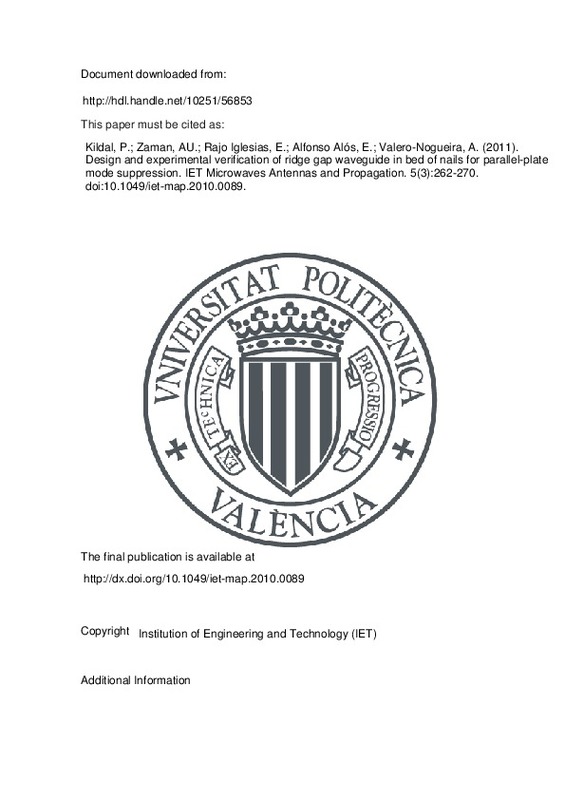Kildal, P.-S., Alfonso, E., Valero-Nogueira, A., & Rajo-Iglesias, E. (2009). Local Metamaterial-Based Waveguides in Gaps Between Parallel Metal Plates. IEEE Antennas and Wireless Propagation Letters, 8, 84-87. doi:10.1109/lawp.2008.2011147
Kildal, P.-S.: ‘Waveguides and transmission lines in gaps between parallel conducting surfaces’, (European Patent Application EP08159791.6)7 July 2008
Rajo-Iglesias, E., Zaman, A. U., & Kildal, P.-S. (2010). Parallel Plate Cavity Mode Suppression in Microstrip Circuit Packages Using a Lid of Nails. IEEE Microwave and Wireless Components Letters, 20(1), 31-33. doi:10.1109/lmwc.2009.2035960
[+]
Kildal, P.-S., Alfonso, E., Valero-Nogueira, A., & Rajo-Iglesias, E. (2009). Local Metamaterial-Based Waveguides in Gaps Between Parallel Metal Plates. IEEE Antennas and Wireless Propagation Letters, 8, 84-87. doi:10.1109/lawp.2008.2011147
Kildal, P.-S.: ‘Waveguides and transmission lines in gaps between parallel conducting surfaces’, (European Patent Application EP08159791.6)7 July 2008
Rajo-Iglesias, E., Zaman, A. U., & Kildal, P.-S. (2010). Parallel Plate Cavity Mode Suppression in Microstrip Circuit Packages Using a Lid of Nails. IEEE Microwave and Wireless Components Letters, 20(1), 31-33. doi:10.1109/lmwc.2009.2035960
Kildal, P.-S. (1990). Artificially soft and hard surfaces in electromagnetics. IEEE Transactions on Antennas and Propagation, 38(10), 1537-1544. doi:10.1109/8.59765
Valero-Nogueira, A., Alfonso, E., Herranz, J. I., & Kildal, P.-S. (2009). Experimental Demonstration of Local Quasi-TEM Gap Modes in Single-Hard-Wall Waveguides. IEEE Microwave and Wireless Components Letters, 19(9), 536-538. doi:10.1109/lmwc.2009.2027051
Lier, E. (1990). Analysis of soft and hard strip-loaded horns using a circular cylindrical model. IEEE Transactions on Antennas and Propagation, 38(6), 783-793. doi:10.1109/8.55573
Sievenpiper, D., Lijun Zhang, Broas, R. F. J., Alexopolous, N. G., & Yablonovitch, E. (1999). High-impedance electromagnetic surfaces with a forbidden frequency band. IEEE Transactions on Microwave Theory and Techniques, 47(11), 2059-2074. doi:10.1109/22.798001
Silveirinha, M. G., Fernandes, C. A., & Costa, J. R. (2008). Electromagnetic Characterization of Textured Surfaces Formed by Metallic Pins. IEEE Transactions on Antennas and Propagation, 56(2), 405-415. doi:10.1109/tap.2007.915442
Lindell, I. V. (2000). Ideal boundary and generalised soft and hard conditions. IEE Proceedings - Microwaves, Antennas and Propagation, 147(6), 495. doi:10.1049/ip-map:20000827
Valero-Nogueira, A., Alfonso, E., Herranz, J. I., & Baquero, M. (2007). Planar slot-array antenna fed by an oversized quasi-TEM waveguide. Microwave and Optical Technology Letters, 49(8), 1875-1877. doi:10.1002/mop.22586
Šipuš, Z., Merkel, H., & Kildal, P.-S. (1997). Green’s functions for planar soft and hard surfaces derived by asymptotic boundary conditions. IEE Proceedings - Microwaves, Antennas and Propagation, 144(5), 321. doi:10.1049/ip-map:19971335
CST Microwave Studio 2008. Available at: www.cst.com
Kehn, M. N. M., & Kildal, P.-S. (2005). Miniaturized rectangular hard waveguides for use in multifrequency phased arrays. IEEE Transactions on Antennas and Propagation, 53(1), 100-109. doi:10.1109/tap.2004.840519
Malcolm Ng Mou Kehn, M. N. M., Nannetti, Cucini, Maci, & Kildal. (2006). Analysis of dispersion in dipole-FSS loaded hard rectangular waveguide. IEEE Transactions on Antennas and Propagation, 54(12), 2275-2282. doi:10.1109/tap.2006.879198
Grbic, A., & Eleftheriades, G. V. (2003). Periodic analysis of a 2-D negative refractive index transmission line structure. IEEE Transactions on Antennas and Propagation, 51(10), 2604-2611. doi:10.1109/tap.2003.817543
Eleftheriades, G.V., and Balmain, K.G.: ‘Metamaterials for controlling and guiding electromagnetic radiation’, (US Patent 6859114 – Filed 2 June 2003)
McKinzie, W.F.: ‘Circuit and method for suppression of electromagnetic coupling and switching noise in multilayer printed circuit boards’, (US Patent No. 7,215,007 B2)
Schellenberg, J. M. (1995). CAD models for suspended and inverted microstrip. IEEE Transactions on Microwave Theory and Techniques, 43(6), 1247-1252. doi:10.1109/22.390179
Anderson, T. N. (1956). Rectangular and Ridge Waveguide. IEEE Transactions on Microwave Theory and Techniques, 4(4), 201-209. doi:10.1109/tmtt.1956.1125063
Pozar, D.: ‘Microwave engineering’, 3rd(Wiley 2005), p. 139
Bosiljevac, M., Sipus, Z., & Kildal, P.-S. (2010). Construction of Green’s functions of parallel plates with periodic texture with application to gap waveguides – a plane-wave spectral-domain approach. IET Microwaves, Antennas & Propagation, 4(11), 1799. doi:10.1049/iet-map.2009.0399
Zaman, A. U., Rajo-Iglesias, E., Alfonso, E., & Kildal, P.-S. (2009). Design of transition from coaxial line to ridge gap waveguide. 2009 IEEE Antennas and Propagation Society International Symposium. doi:10.1109/aps.2009.5172186
Sharp, E. D. (1963). A High-Power Wide-Band Waffle-Iron Filter. IEEE Transactions on Microwave Theory and Techniques, 11(2), 111-116. doi:10.1109/tmtt.1963.1125611
KIRINO, H., OGAWA, K., & OHNO, T. (2008). A Variable Phase Shifter Using a Movable Waffle Iron Metal Plate and Its Applications to Phased Array Antennas. IEICE Transactions on Communications, E91-B(6), 1773-1782. doi:10.1093/ietcom/e91-b.6.1773
[-]







![[Cerrado]](/themes/UPV/images/candado.png)


